Altering Home – Cultural City of East Asia 2018 Kanazawa: 21st Century Museum of Contemporary Art, Kanazawa
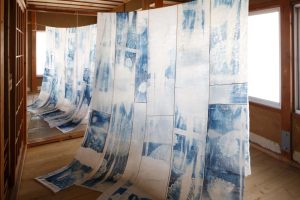
Ama’s Home / Boat Floating on Memory with the Colour of Emptiness, 2018
Cyanotype on used ramie and cotton clothes from Kanazawa, linen yarn, sinker, fishhook
Installation View, 21st Century Museum of Contemporary Art, Kanazawa
Photo: Keizo Kioku
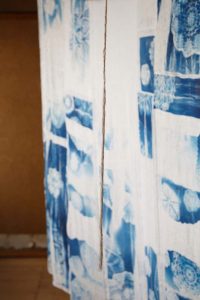
Ama’s Home / Boat Floating on Memory with the Colour of Emptiness, 2018
Cyanotype on used ramie and cotton clothes from Kanazawa, linen yarn, sinker, fishhook
Installation View, 21st Century Museum of Contemporary Art, Kanazawa
Photo: Keizo Kioku
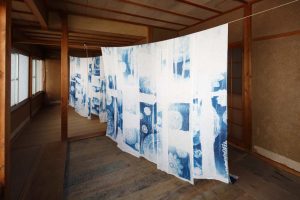
Ama’s Home / Boat Floating on Memory with the Colour of Emptiness, 2018
Cyanotype on used ramie and cotton clothes from Kanazawa, linen yarn, sinker, fishhook
Installation View, 21st Century Museum of Contemporary Art, Kanazawa
Photo: Keizo Kioku
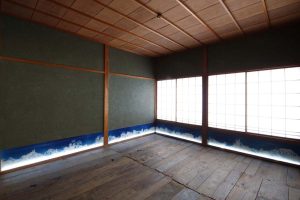
Ama’s Home / Boat Floating on Memory with the Colour of Emptiness, 2018
Cyanotype on used ramie and cotton clothes from Kanazawa, linen yarn, sinker, fishhook
Installation View, 21st Century Museum of Contemporary Art, Kanazawa
Photo: Keizo Kioku
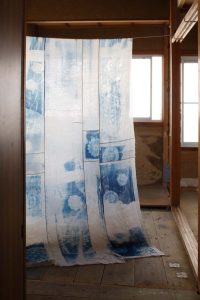
Ama’s Home / Boat Floating on Memory with the Colour of Emptiness, 2018
Cyanotype on used ramie and cotton clothes from Kanazawa, linen yarn, sinker, fishhook
Installation View, 21st Century Museum of Contemporary Art, Kanazawa
Photo: Keizo Kioku
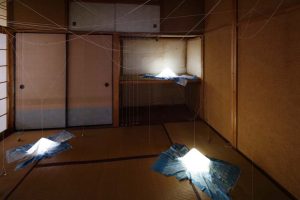
Ama’s Home / Boat Floating on Memory with the Colour of Emptiness, 2018
Cyanotype on used ramie and cotton clothes from Kanazawa, linen yarn, sinker, fishhook
Installation View, 21st Century Museum of Contemporary Art, Kanazawa
Photo: Keizo Kioku
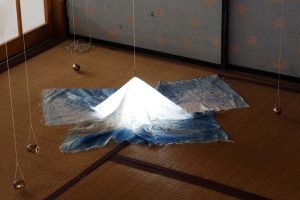
Ama’s Home / Boat Floating on Memory with the Colour of Emptiness, 2018
Cyanotype on used ramie and cotton clothes from Kanazawa, linen yarn, sinker, fishhook
Installation View, 21st Century Museum of Contemporary Art, Kanazawa
Photo: Keizo Kioku
Haji Oh
15 Sep - 4 Nov 2018
Cultural City of East Asia 2018 Kanazawa – Altering Home
Ama’s Home / Boat Floating on Memory with the Colour of Emptiness, 2018
Seen in terms of East Asian connections, the sea is a pathway linking islands and the mainland. Stories that are connected through sea routes are also stories about the lives of people who cross the sea. This work traces one of those stories: the live of the Ama, female divers also known as “sea-women”.
“My interest in how the Ama lived began when I heard how an Ama’s diving costume made of white cloth had been found among the belongings of my grandmother, who had migrated to Osaka from the Korean island of Jeju.” – Haji Oh
Hegurashima, an island off the coast of Wajima in Ishikawa Prefecture, is known as an island of Ama with roots in Kanegasaki, Fukuoka Prefecture. It is said that Ama moved back and forth between Kanegasaki and Jeju. The Ama of Hegurashima led a habitually mobile life, using their boats for fishing and traveling sales, An Ama’s boat was a tool of her trade and home. The Ama of Jeju traveled out to places such as China and Russia, as well as over to Japan, in search of work. The movement of these women across the sea to work with their own physical skills seems to be one of the initial forms of independent labor migration by women in Asia.
Knitted patterns recorded in the “Memories of Light, Records of Knitting” workshop facilitated by Haji Oh, a product of research carried out mainly in Kanazawa, were transferred onto fabrics gathered from the same region. These vestiges of knitting aim to trigger the memories of those who view them, playing the role of a universal tool connecting a work of art with its audience. They are also an expression of a very personal accrual tool connecting a work of art with its audience. Additionally, they are also an expression of very personal accrual of time, one that cannot be rendered uniformly. The fragments of cloth evoke something whole: a used Kimono slip that its worn, cloth as a second skin. The lives of those who knitted, those who came from over the sea…their fabric hold the patterns if knitting with the colour of emptiness that, I hope, will furnish opportunities for us to “imagine with intimacy”.
See extract from exhibition catalogue here
